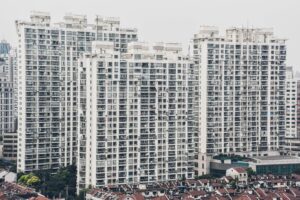If you live in a city, chances are, you are quite familiar with these scenarios: it takes you 40 minutes to travel five kilometres, you stand in long queues to simply get cash out of an ATM and the only way you can effectively follow social distancing is by locking yourself indoors because there is no way you can keep six feet distance from people out on the streets. In this blog, Tata Communications’ Praveen Arora, Vice President – Internet of Things (Business Unit), explains why these are only some of the unique challenges of mass urbanisation; or, everyday life as you know it.

In 2018, United Nations recorded that 55% of the world’s population is living in urban areas, and this is expected to increase to 68% by 2050. India already has 34% of its population occupying urban areas. And every year, this percentage increases. However, a looming question remains – how will these urban cities effectively support basic needs of this ever-growing population while also ensuring sustainable opportunities, growth, and resources for everyone , and more so today, in terms of ensuring safety during this pandemic.
“With the increasing number of Internet of Things (IoT) sensors and devices deployed across urban areas, the solution could very well lie within the data gathered from these cities. If analysed regularly and accurately, data could offer insights on your city’s strengths and pain points to facilitate informed decision making that can help create an equitable lifestyle.”
This is where predictive analytics play a crucial role – helping cities improve mobility, infrastructure and resource management in a cost-effective manner.
Identify the patterns and then break them
Predictive analytics can unlock hidden patterns. Imagine if we could forecast how traffic on a street is impacted due to monsoon or how rescheduling the sequence of traffic signals by few seconds can reduce the number of cars, resulting in less pollution. Multiple simple and effective solutions can be identified through analytics.
“During these times, we have seen few countries who have been able to track and fight the pandemic by conducting timely analysis of data generated through IoT devices in real-time. They have successfully leveraged data science to develop a monitoring system to identify and assess every citizen’s travel history and the level of exposure to the virus.”
 Several other cities have also explored the potential of predictive analytics to bring positive changes for its citizens. Los Angeles is using data to maintain clean streets, water management, assess and enhance diversity in police recruits, increase participation in sports and many other such initiatives. Barcelona has installed smart irrigation systems across parks and gardens to gauge humidity levels underground and effectively assess water requirements. This exercise resulted in saving 600,000 litres of water annually. These are just two of the many cities deploying intelligent, data-driven solutions to address everyday challenges, thereby benefiting the environment, people and ultimately, economy.
Several other cities have also explored the potential of predictive analytics to bring positive changes for its citizens. Los Angeles is using data to maintain clean streets, water management, assess and enhance diversity in police recruits, increase participation in sports and many other such initiatives. Barcelona has installed smart irrigation systems across parks and gardens to gauge humidity levels underground and effectively assess water requirements. This exercise resulted in saving 600,000 litres of water annually. These are just two of the many cities deploying intelligent, data-driven solutions to address everyday challenges, thereby benefiting the environment, people and ultimately, economy.
A safer, sustainable society
India is taking note of these best practices across geographies and making its way to exploring the wonders of analytics. The Government of India’s Smart Cities Mission has received further allocation of INR 6450 crore this fiscal and the addition of five new cities to the list of existing 100 smart cities. Predictive analytics will be the foundation for the success of smart cities by addressing critical areas such as public safety, upgraded mobility and more.
Insights from real-time crime mapping can help in identifying high crime-prone zones in the city and such data can be immensely helpful during crisis situations by means of equitable resource distribution for problem-solving. According to McKinsey, cities that deploy the right technological applications could reduce crime rates and fatalities by as much as 10%. The same solution can be applied to monitor areas with highest COVID cases and build strategies around treating each and every individual curbing the spread of the virus.
- Employee or worker safety
To enhance the employee or worker safety, the predictive analysis is being used to determine safe distancing as well as avoiding safety incidents by understanding patterns how an individual navigates in a given work environment. The predictive safety solution is also being considered in safe social distancing norms for resuming business operations in some smart cities post COVID-19 restart.
Enhancing urban mobility has been one of India’s top concerns. And why not? If we look at Bengaluru, it’s the most traffic-congested city in the world. Data enables real-time traffic monitoring and control to understand the connection between modes of transport for faster travel times by recognising patterns and highlighting the root causes, reducing operational cost and increasing efficiency.
- Effective waste management
India generates over 62 million tonnes of solid waste every year. The analysis of the waste generation pattern as per the area, season and times the dustbin is filled to a decided level can help build an area wise strategy to collect waste. This can help in reducing cost, manpower, overflowing of waste, and reduction of carbon emission.
- Sustainability and growth
Data analytics allows cities to monitor and manage an extensive range of infrastructure and to use predictive maintenance in the right areas to minimise costs, risks and carbon footprints. It also has a role to play across all aspects of public service and city operations. Think about the impact of providing energy-efficient buildings, air quality sensors and renewable energy resources that result in higher operational efficiencies and a decrease in environmental damage.
“A simple insight based on usage data and seasonal patterns can suggest best mode of energy optimisation from a renewable source or a simple control of smart street lights or building lighting control based on movement can significantly reduce carbon footprints. For instance with discussions around malls, shops and eateries to be open for 24/7 in Mumbai, here predictive analytics can monitor the number of footfalls.”
The data can aid owners of the premises and authorities to strategies the workforce, usage of electricity and the success ratio of this initiative. As  the smart city projects make their journey from innovation to regulation, there are many hurdles we are yet to overcome. India has reached the experimentation stage, where both government and businesses have started to leverage advanced technologies.
the smart city projects make their journey from innovation to regulation, there are many hurdles we are yet to overcome. India has reached the experimentation stage, where both government and businesses have started to leverage advanced technologies.
While there is no end to the data generated by cities, gathering, storing and analysing data requires robust infrastructure and experienced human capital. Yet, we must start… and start now. For a country to achieve equitable resource distribution is the first but crucial step to paving way for the right social and economic opportunities.
Discover more about how IoT lays the foundations for the buildings of the future.
Transformational Hybrid SolutionsOur cloud-enablement services offer the best performance on your traffic-heavy websites or mission-critical applications.
Core NetworksTata Communications™ global IT infrastructure and fibre network delivers the resources you need, when and where you need them.
Network Resources
Unified Communications As A ServiceBreak the barriers of borders efficiently and increase productivity with Tata Communications’ UC&C solutions.
Global SIP ConnectEmpower your business with our SIP network and witness it grow exponentially.
InstaCC™ - Contact Centre As A ServiceCloud contact centre solutions for digital customers experience and agent productivity.
DIGO – Communications Platform as a ServiceDIGO is an in-network cloud communications platform, enabling you to power up converged contextual human-to-everything conversations globally.
Unified Communication Resources Case studies, industry papers and other interesting content to help you explore our unified communications solution better.
IoT SolutionsThe Internet of Things is transforming the way we experience the world around us for good. Find out more about our Internet Of Things related solutions here.
Mobility SolutionsTata Communications’ mobility services enable your enterprise to maintain seamless communication across borders, with complete visibility of cost and usage.
Mobility & IoT Resources
Multi-Cloud SolutionsWith enterprises transitioning to a hybrid multi-cloud infrastructure, getting the right deployment model that yields ROI can be a daunting task.
Cloud ComplianceCompliant with data privacy standards across different countries and is also designed to protect customers’ privacy at all levels.
IZO™ Cloud Platform & ServicesIZO™ is a flexible, one-stop cloud enablement platform designed to help you navigate complexity for more agile business performance.
Managed Infrastructure ServicesIntegrated with our integrated Tier-1 network to help your business grow efficiently across borders.
Cloud PartnersWe support a global ecosystem for seamless, secure connectivity to multiple solutions through a single provider.
Cloud Resources
Governance, Risk, and ComplianceRisk and Threat management services to reduce security thefts across your business and improve overall efficiencies and costs.
Cloud SecurityBest-in-class security by our global secure web gateway helps provide visibility and control of users inside and outside the office.
Threat Management - SOCIndustry-leading threat-management service to minimise risk, with an efficient global solution against emerging security breaches and attacks.
Advanced Network SecurityManaged security services for a predictive and proactive range of solutions, driving visibility and context to prevent attacks.
Cyber Security ResourcesCase studies, industry papers and other interesting content to help you explore our securtiy solution better.
Hosted & Managed ServicesTata Communications provide new models for efficient wholesale carrier voice service management. With our managed hosting services make your voice business more efficient and better protected
Wholesale Voice Transport & Termination ServicesYour long-distance international voice traffic is in good hands. End-to-end, voice access & carrier services which includes voice transport and termination with a trusted, global partner.
Voice Access ServicesTata Communication’s provide solutions which take care of your carrier & voice services, from conferencing to call centre or business support applications.
Carrier Services Resources
CDN Acceleration ServicesOur CDN Web Site Acceleration (WSA) solution helps deliver static and dynamic content, guaranteeing higher performance for your website.
CDN SecuritySafeguard your website data and customers’ information by securing your website from hacks and other mala fide cyber activities.
Video CDNDeliver high-quality video content to your customers across platforms – website, app and OTT delivery.
CDN Resources
Elevate CXIncrease customer satisfaction while empowering your service team to deliver world-class customer experience and engagement.
Live Event ServicesTata Communications’ live event services help battle the share if eyeballs as on-demand video drives an explosion of diverse content available on tap for a global audience.
Media Cloud Infrastructure ServicesTata Communications’ media cloud infrastructure offers flexible storage & compute services to build custom media applications.
Global Media NetworkTata Communications’ global media network combines our expertise as a global tier-1 connectivity provider with our end-to-end media ecosystem.
Use CasesUse cases of Tata Communications’ Media Entertainment Services
Remote Production SolutionsMedia contribution, preparation and distribution are highly capital-intensive for producers of live TV and video content, and their workflows are complex.
Media Cloud Ecosystem SolutionsThe Tata Communications media cloud infrastructure services offer the basic building blocks for a cloud infrastructure-as-a-service.
Global Contribution & Distribution SolutionsTata Communications’ global contribution and distribution solution is built to reduce capital outlay and grow global footprint.
Satellite Alternative SolutionsAs more and more consumers choose to cut the cord & switch to internet-based entertainment options, broadcasters are faced with capital allocation decisions.
LeadershipA look into the pillars of Tata communications who carry the torch and are living embodiment of Tata’s values and ethos.
Culture & DiversityHere at Tata Communications we are committed to creating a culture of openness, curiosity and learning. We also believe in driving an extra mile to recognize new talent and cultivate skills.
OfficesA list of Tata Communications office locations worldwide.
SustainabilityTata Communications adopts a holistic approach and harnesses the power of new-age technologies like 5G, IoT and AI to build a sustainable digital world.
FAQCheck out our FAQs section for more information.
BoardHave a look at our board of members.
ResultsFind out more about our quarterly results.
Investor PresentationsFollow our repository of investor presentations.
FilingsGet all information regarding filings of Tata communications in one place.
Investor EventsAll investor related event schedule and information at one place.
GovernanceAt Tata, we believe in following our corporate social responsibility which is why we have set up a team for corporate governance.
SharesGet a better understanding of our shares, dividends etc.
SupportGet all investor related contact information here.


